
Europe and Mediterranean: Greece, Adriatic and Western Mediterranean Voyage
Cunard
This 18-night voyage combines a mix of sea days and time in port, offering the chance to discover all that Queen Anne has to offer, as well as the fascinating histories of Cagliari, Corfu, and more.

Executive Member Benefit
Executive Members receive an annual 2% Reward, up to $1,250, on qualified Costco Travel purchases
Digital Costco Shop Card
Member Exclusive: Digital Costco Shop Card with every Cunard sailing†
Sailing Itinerary

Note: Cruise itineraries are subject to change. Please verify ports and times directly with the cruise line.
Overview
Southampton is a port city on England’s south coast. It’s home to the Sea City Museum, with an interactive model of the Titanic, which departed from Southampton in 1912. Nearby, Southampton City Art Gallery specializes in modern British art. Solent Sky Museum features vintage aircraft like the iconic Spitfire. Tudor House & Garden displays artifacts covering over 800 years of history, including a penny-farthing bike.
Overview
The capital of the region with a population of 168,000, Cartegena was founded, as its name suggests, by the Carthaginians in 227 BC and it became Hannibal’s capital city on the Iberian Peninsula. Today it is a modern, industrial city although relics of the past are still highly visible. The narrow streets of the old town were built around the ruined 13th-century cathedral. There are several sites of historical interest including the remains of the Roman road, an old Roman theatre and the Literna (an ancient lighthouse of Moorish origins). Cartagena’s ancient seaport and naval dockyard is where the first submarine was built in 1900 and where submarines are still built today. The port consists of a deep bay with a natural harbour, hence the town’s historical importance. Cartagena has a large shopping centre, plenty of supermarkets and other amenities you would expect to find in a large town including a hospital, schools and sports facilities. The town is the major service centre for the Costa Calida urbanizations that continue to develop around it.Cartegena is 30 minutes drive from Murcia via the N301San Javier airport is 15km from Cartagena.The excellent golf courses at La Manga, which has 3 18-hole courses of international standard, are 20km away.
Overview
The Strait of Messina divides the island of Sicily from Calabria in southern Italy and is 3km wide.
Overview
Corfu Town (Kerkyra) is a principal port and the largest town in the Ionian islands. It is built between two Venetian castles, having its unique atmosphere. It is a thriving mass of shops and businesses, set amongst a captivating and charming assortment of elegant buildings, churches, imposing fortresses, and narrow alleyways leading to hidden squares. The tall buildings with the 'volta' (arches), the 'cantina' (narrow flagstoned streets), and the 'meralgia' (sea walls) are showing all a clear Italian influence. One of the most beautiful walks in the town is around the Esplanade (Spianada square), one of the biggest squares in Europe which is the hub of the Corfiot's life. Here you can walk around or sit in one of the many cafe bars underneath the arches of the 'Liston', a name probably derived from a similar promenade in Venice. Liston was built during the imperial French occupation and is reminiscent of the larger 'Arcades' of the Rue de Rivoli in Paris. On the upper side of the Esplanade stands a memorial to the British Lord High Commissioner Sir Thomas Maitland, built in 1816 in the shape of a circular building with Ionian columns. The Corfiots called this building 'sterna' (cistern) because this was where the entrance to the largest underground cistern of the town was to be found. Near the Maitland's monument, in front of the building where the Ionian Academy was housed, stands the statue of John Capodistrias, the first President of Greece. It is a work from the end of the 19th century showing the Governor standing deep in thought. Opposite the Liston is the Old Fortress and 'Anthonas', the Municipal Gardens. In the gardens is the statue of Lord Guilford, showing the founder of the Ionian Academy in his academic robes holding an open book. Nearby are the busts of two famous Corfiots, the poet Lorenzo Mavilis and the writer Dinos Theotokis. At the northern end of the Esplanade stands the Palace of St. Michael and St. George, one of the most elegant buildings in Corfu. Opposite the west front of the palace is a beautiful building that now houses the Reading Society of Corfu, the oldest cultural institute in modern Greece, founded in 1836. The Reading Society contains a unique library of Greek and foreign books as well as a large collection of manuscripts, newspapers, periodicals, paintings, maps and engravings mostly related to the Ionian islands. As one's gaze leaves the Esplanade, after lingering on the palace, it embraces a magnificent view towards the coastal road (Arseniou Street) with its sea walls Following along this road will take you to the Old Harbour of Corfu and the other Venetian castle, the one called the New Fortress. Along this road, the narrow lanes ('cantounia') lead to the Campielo, the oldest quarter of the town. Here the visitor can find the oldest houses and many of the historic churches in Corfu. At the northern end of Capodistria Street stands the Capodistria Mansion, an excellent example of neo-classical architecture. It was built in 1835 by the Corfiot architect John Chronis and is considered one of the most beautiful buildings in Greece. Here John Capodistrias, the first President of Greece, was born. Another notable landmark in the old town is the central market. The most interesting street here is Nickiforou Theotoki as the rows upon rows of 'volta' standing on their stone columns and the tall buildings form one of the most characteristic aspects of Corfu Town. In a little square on Nickiforou Theotoki Street stands the building of the Ionian Bank, which was built in 1846 displaying a well-proportioned facade with finely detailed Ionian pilasters and pediment. On the first floor of the building,g the Paper Money Museum is housed. At the far end of the square is the Church of St. Spyridon. It shelters the body of St. Spyridon, the patron saint of Corfu and one of the great Saints of Greek Orthodoxy, and draws a constant stream of pilgrims from all over Greece every year. On the Evgeniou Voulgareos Street stands the crenellated belfry of the Roman Catholic Church of the Annunciation a venerable building from the end of the 14th century. The whole building was destroyed in the World War II bombing, and the only remains are the belfry, two inscriptions, and a bas-relief representing war trophies. Between Evgeniou Voulgareos Street and a modern square stands the most elegant of the Venetian buildings in Corfu, the Town Hall in baroque style. At the end of Moustoxydi Street stands another building of the period of British rule, the historic Ionian Parliament. At the junction of the Garitsa coastal road and Alexandras Avenue stands the Douglas Obelisk, which also belongs to the same period, erected in honor of the Lord High Commissioner Sir Howard Douglas, to whom Corfu owes a lot of public works and philanthropic institutions.
Overview
Dubrovnik - the city of a unique political and cultural history (the Dubrovnik Republic, the Statute from 1272), of world-famous cultural heritage and beauty (inscribed on the List of World Heritage Sites by Unesco) - is one of the most attractive and famous cities of the Mediterranean. Apart from its outstanding natural beauties and well-preserved cultural and historical heritage, Dubrovnik also offers high-quality visitor opportunities. It is also the city of hotels, high ecological standards, and tourist programs, and is equally attractive in all seasons. Its geographical isolation is compensated by high traffic and communication standards - especially through air traffic and fast hydrofoil boats. The tourist development of Dubrovnik started before the First World War; quite soon, the exclusiveness of its attractions made Dubrovnik a powerful international tourist center. The sightseeing of Dubrovnik and its monuments requires several days. However, already a walk through Stradun, through narrow streets and small squares, monumental ramparts and fortresses, provides enough opportunities to experience the millennial beauty of its shell-shaped urban core, centuries of building, stone-cutting, carving and engraving, the history of the Duke's Palace, libraries, the oldest pharmacy in the south of Europe, etc. Dubrovnik offers individual choice among numerous museums and galleries, which contain the jewels of Croatian heritage. The Dubrovnik Museum in the Duke's Palace keeps 15,500 exhibits in its cultural and historical department. A collection of furniture from the 17th-19th century, uniforms of dukes and councilors, aristocratic garments, and many other items are exhibited in the authentic halls of the palace. The Maritime Museum (situated in the fortress Sveti Ivan) has several exhibits on permanent display, related to the maritime affairs of Dubrovnik and Croatia on the whole, with a particular emphasis on the history of the Dubrovnik Republic. The museum of the Franciscan monastery keeps all inventories of the old pharmacy, as well as the works of Dubrovnik jewelers, painters, and embroiders. The Museum of the Dominican Monastery exhibits valuable examples of Dubrovnik paintings from the 15th and 16th centuries, as well as sculptures, jewelry, manuscripts, incunabula, and notes (music). The treasury of the Dubrovnik cathedral keeps the relics of St. Blaise, patron of Dubrovnik, and numerous paintings and works of art. The Rupe Ethnographical Museum presents traditional occupations and the rural architecture of the region of Dubrovnik, national costumes, and hand-made textiles. Very attractive is also the Aquarium of the Institute of Biology, situated in the fortress Sveti Ivan, comprising interesting marine species. Dubrovnik has several churches, monasteries, and hotels scattered all over the town. Its coastal belt is adorned with several marinas, piers, and promenades. Because of the magnificent view of the medieval Dubrovnik, a walk along the town ramparts is a must for each visitor. A great number of Dubrovnik restaurants and taverns offer delicious specialties of local and international cuisine. Sports and recreational facilities include playgrounds, courts, and requisites for all sports in the sea and on the ground, from tennis and table tennis to sailing and yachting. There are also several gyms and fitness centers with swimming pools, saunas, massage, aerobics, solarium, box gyms, etc. Dubrovnik is famous for quality hotels. Most of them are situated on the Lapad peninsula and in the area of Ploce, southeast of the old town. The hotel complex Dubrava - --Babin Kuk on Lapad has all the features of a small town. It has a shopping center, a bank, an outpatient department, many restaurants and cafés, and a street called the "New Stradun", which connects all hotels. Dubrovnik is the city of an outstanding cultural and artistic life. The most important event in the cultural life of the city is the Dubrovnik Summer Festival (10th of July - 25th of August), traditionally held since 1950. It is a theatre and classical and folk music festival since 1956 included in the calendar of world festivals and as such one of the most famous cultural events in the world. Concerts and other performances take place on open stages in the town (Gunduliceva Poljana, Drziceva Poljana, Lovrijenac, Revelin)or in beautiful interiors of the most famous buildings (Duke's Palace, cloisters, and churches). The repertoire includes works of Croatian and world classics, performed by the leading personalities from Croatia and abroad, including several world-famous actors, directors, conductors, etc. So far several hundred of them have performed in Dubrovnik. An important part of the Festival is his performances of local (Lindo, Lado) and foreign folk music ensembles. The artistic life of Dubrovnik is characterized by numerous exhibitions taking place throughout the year. Apart from already renowned galleries - the Art Gallery (Put Frana Supila 23), its exhibition space Luza Art Centre (Stradun), Sebastian - occasional and permanent exhibitions are also held in other spaces as well. Very famous are also Dubrovnik carnival festivities - so-called Dubrovnik "karnevo" (local variant of the word "carnival"), held ever since the early Middle Ages, when they were brought from neighboring Italy. Another important event is the Feast Day of St. Blaise, also the Day of Dubrovnik (3rd of February). The feast takes place for the whole week, including religious ceremonies, a procession through the town, concerts, sports events, entertainment, and carnival programs. Excursions to Dubrovnik during that week are regularly organized.
Overview
Zadar, a city on Croatia’s Dalmatian coast, is known for the Roman and Venetian ruins of its peninsular Old Town. There are several Venetian gates in the city walls. Surrounding the Roman-era Forum is the 11th-century St. Mary’s Convent, with religious art dating to the 8th century. There’s also the grand, 12th-century St. Anastasia’s Cathedral and the round, 9th-century pre-Romanesque Church of St. Donatus.
Overview
The Strait of Messina divides the island of Sicily from Calabria in southern Italy and is 3km wide.
Overview
Cagliari is the capital city of the Italian island of Sardinia. It’s known for the hilltop Castello, a medieval walled quarter situated high over the rest of the town. Architectural highlights include the 13th-century Cagliari Cathedral. Housed in a former arsenal, the Museo Archeologico Nazionale di Cagliari displays bronze objects, Roman ceramics, and artifacts from the Nuragic age to the Byzantine era.
Overview
Málaga is a port city on southern Spain’s Costa del Sol, known for its high-rise hotels and resorts jutting up from yellow-sand beaches. Looming over that modern skyline are the city’s 2 massive hilltop citadels, the Alcazaba and ruined Gibralfaro, remnants of Moorish rule. The city's soaring Renaissance cathedral is nicknamed La Manquita ("one-armed lady") because one of its towers was curiously left unbuilt.
Overview
Gibraltar is a British Overseas Territory and headland, on Spain's south coast. It’s dominated by the Rock of Gibraltar, a 426m-high limestone ridge. First settled by the Moors in the Middle Ages and later ruled by Spain, the outpost was ceded to the British in 1713. Layers of fortifications include the remains of a 14th-century Moorish Castle and the 18th-century Great Siege Tunnels, which were expanded in WWII.
Overview
Southampton is a port city on England’s south coast. It’s home to the Sea City Museum, with an interactive model of the Titanic, which departed from Southampton in 1912. Nearby, Southampton City Art Gallery specializes in modern British art. Solent Sky Museum features vintage aircraft like the iconic Spitfire. Tudor House & Garden displays artifacts covering over 800 years of history, including a penny-farthing bike.
Onboard the Queen Anne
Queen Anne
Year Built: 2022
Double Occupancy Capacity: 3000
Let Queen Anne® become your home away from home as you explore some of the world’s most enticing locations during her inaugural season. Whether you seek plentiful sea days to truly enjoy the ship, or you’d prefer a voyage on which you’ll discover a new destination almost every day, Queen Anne’s choices do not disappoint. Be a part of history as Cunard's newest ship is welcomed for the very first time, turning heads in destinations all over the world.
Activities & Services (included in cruise)
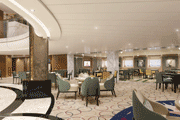
Games Room
- Card Room
- Casino
- Disco/Nightclub
- Movies
- Theater/Show Lounge
- Fitness Center
- Sauna/Steam Room
- Educational Programs
- Pool - Children's
- Pool - Outdoor
- Whirlpool/Jacuzzi
- Art Gallery
- Bars/Lounges
- Library
- Educational Programs
- Organized Age Specific Activities
- Teen Center or Disco
- Teen Programs
- Duty-Free Shops/Boutiques
- Elevators
- Safe Deposit Boxes
Activities & Services (available for an extra fee)
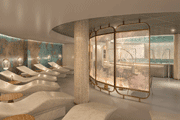
Mareel Thermal Spa
- Beauty Salon
- Full-Service Spa
- Spa Services/Massage
- Internet Center
- Babysitting
- Dry Cleaning/ Laundry Service
- Infirmary/Medical Center
- Self-Service Laundromat
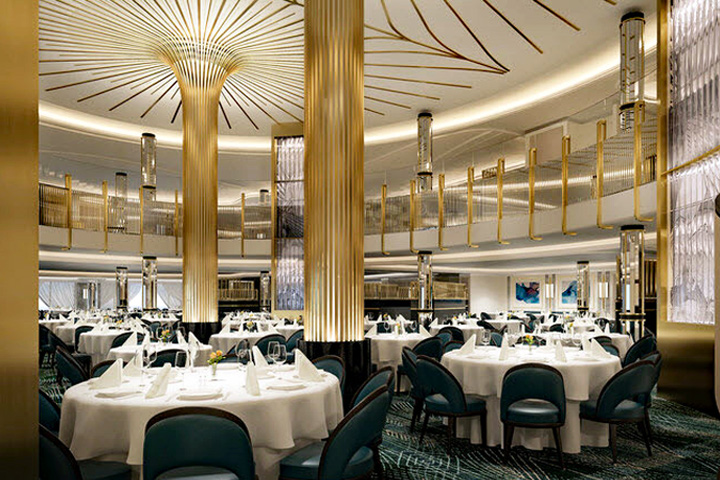
Britannia Restaurant
Main Dining
Britannia Restaurant: This main restaurant invites you to enjoy breakfast, lunch and dinner with a real sense of occasion. Dining is a highlight of each Cunard voyage and the grandeur of the Britannia Restaurant ensures it's always memorable, especially on Gala Evenings. Experience a stylish and vibrant atmosphere and be tempted by freshly prepared dishes which range from twists on traditional favorites to contemporary selections. If you decide to join us here for breakfast or lunch you'll find it traditional and relaxed, whereas at dinner this glamorous venue really sparkles. Choose from 6pm, 8pm or open dining. with last orders at 9pm. Reservations can be made in advance.
Princess Grill Restaurant: The exclusive Princess Grill Restaurant will offer an exquisite and unforgettable dining experience. You'll be met with an array of tempting choices to delight the taste buds and pique your curiosity for the next course.
Queens Grill Restaurant: The Queens Grill Restaurant is truly the epitome of luxurious, intimate dining. With a stellar menu and an atmosphere to match, enjoy the ultimate in sophistication and exclusivity.
Britannia Club Restaurant: The Britannia Club Restaurant offers an exemplary dining experience and a sense of intimate exclusivity. Here you can enjoy the added pleasure that comes from knowing you have a table reserved throughout your voyage. Even the most discerning of taste buds will find dishes to please from a menu that offers a varied selection of contemporary and international choices as well as special dishes curated by the chef, only available in Britannia Club.
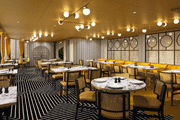
Tramonto Restaurant
Specialty Dining
Tramonto: Inspired by fresh Mediterranean flavors, with a sprinkling of African and Arabic influences, Tramonto offers simple and authentic dishes that pay homage to Europe's sunshine region.
Aji Wa: Aji Wa, meaning 'harmony of flavors', combines the signature tastes of Japan with the artistry of skilled chefs for a truly authentic dining experience. Menus evolve across the year to reflect the seasonality of ingredients and Queen Anne's location. Where you choose to sit (and the time of day you visit) will also influence how your experience unfolds.
Sir Samuel's: Paying homage to Cunard's founder, Sir Samuel's is a culinary coupling of land and ocean, where nothing (least of all the ingredients) comes as standard. The most succulent steaks; subtly smoked and served with your choice of knife. Fruit de mer platters infused with all the flavors of the sea. Irresistible Dover sole delicately deboned at your table. These are the signature tastes Sir Samuel's invites you to indulge in.
Aranya: Designed to delight and surprise, Aranya (meaning forest or wilderness in Sanskrit) will take you on a sensory tour of the Indian subcontinent with playful interpretations of classic Indian cuisine.
The Golden Lion: Sunday roasts with lashings of gravy. 'Proper' pints served straight from the tap. Bloody Marys as red as the ship's funnels. If the day calls for classic British pub fare, look no further than Queen Anne's Golden Lion.
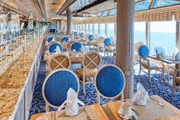
The Lido Court
Casual Dining
The Lido Court: Classic and continental flavor pairings bring the world to your plate. Welcoming guests from early morning until late in the evening, this informal dining venue is like nowhere else you'll dine at on board. Wonderfully laidback, no matter what time of day you visit, the Lido is a dining experience anchored around buffet-style self-service, inviting you to indulge as much or as little as you like.
Room Service: Delicious, freshly prepared food delivered direct to your stateroom, compliments of Cunard®
Well-appointed inside staterooms are a haven of comfort and style to enjoy during your voyage. Features include a Sealy Cunarder bed configurable to king-size or two single beds, satellite TV with movie and music channels, bathroom with a walk-in shower, bathrobes and slippers and more.
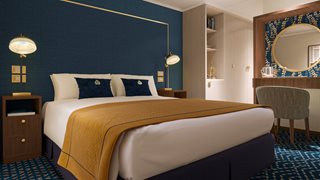
Category: IA
With a variety of locations to choose from on board, our well-appointed Britannia Inside staterooms are a haven of comfort and style during your voyage. Your Britannia Inside stateroom includes:- Choice of Early, Late, and Open Dining in the Britannia Restaurant.
- Cunarder bed configurable to king-size or two single beds.
- Bathroom with a walk-in shower.
- Satellite TV with movie and music channels.
- Feature vanity and desk with hairdryer.
- UK, USA, European, and USB power sockets.
- Penhaligon's toiletries.
- Bathrobes and slippers.
- Tea and coffee-making facilities.
- Welcome sparkling wine.
- Complimentary room service menu.
- A dedicated steward to keep your stateroom in fine order day and night.

Category: IB
With a variety of locations to choose from on board, our well-appointed Britannia Inside staterooms are a haven of comfort and style during your voyage. Your Britannia Inside stateroom includes:- Choice of Early, Late, and Open Dining in the Britannia Restaurant.
- Cunarder bed configurable to king-size or two single beds.
- Bathroom with a walk-in shower.
- Satellite TV with movie and music channels.
- Feature vanity and desk with hairdryer.
- UK, USA, European, and USB power sockets.
- Penhaligon's toiletries.
- Bathrobes and slippers.
- Tea and coffee-making facilities.
- Welcome sparkling wine.
- Complimentary room service menu.
- A dedicated steward to keep your stateroom in fine order day and night.

Category: IC
With a variety of locations to choose from on board, our well-appointed Britannia Inside staterooms are a haven of comfort and style during your voyage. Your Britannia Inside stateroom includes:- Choice of Early, Late, and Open Dining in the Britannia Restaurant.
- Cunarder bed configurable to king-size or two single beds.
- Bathroom with a walk-in shower.
- Satellite TV with movie and music channels.
- Feature vanity and desk with hairdryer.
- UK, USA, European, and USB power sockets.
- Penhaligon's toiletries.
- Bathrobes and slippers.
- Tea and coffee-making facilities.
- Welcome sparkling wine.
- Complimentary room service menu.
- A dedicated steward to keep your stateroom in fine order day and night.

Category: ID
With a variety of locations to choose from on board, our well-appointed Britannia Inside staterooms are a haven of comfort and style during your voyage. Your Britannia Inside stateroom includes:- Choice of Early, Late, and Open Dining in the Britannia Restaurant.
- Cunarder bed configurable to king-size or two single beds.
- Bathroom with a walk-in shower.
- Satellite TV with movie and music channels.
- Feature vanity and desk with hairdryer.
- UK, USA, European, and USB power sockets.
- Penhaligon's toiletries.
- Bathrobes and slippers.
- Tea and coffee-making facilities.
- Welcome sparkling wine.
- Complimentary room service menu.
- A dedicated steward to keep your stateroom in fine order day and night.

Category: IE
With a variety of locations to choose from on board, our well-appointed Britannia Inside staterooms are a haven of comfort and style during your voyage. Your Britannia Inside stateroom includes:- Choice of Early, Late, and Open Dining in the Britannia Restaurant.
- Cunarder bed configurable to king-size or two single beds.
- Bathroom with a walk-in shower.
- Satellite TV with movie and music channels.
- Feature vanity and desk with hairdryer.
- UK, USA, European, and USB power sockets.
- Penhaligon's toiletries.
- Bathrobes and slippers.
- Tea and coffee-making facilities.
- Welcome sparkling wine.
- Complimentary room service menu.
- A dedicated steward to keep your stateroom in fine order day and night.

Category: IF
With a variety of locations to choose from on board, our well-appointed Britannia Inside staterooms are a haven of comfort and style during your voyage. Your Britannia Inside stateroom includes:- Choice of Early, Late, and Open Dining in the Britannia Restaurant.
- Cunarder bed configurable to king-size or two single beds.
- Bathroom with a walk-in shower.
- Satellite TV with movie and music channels.
- Feature vanity and desk with hairdryer.
- UK, USA, European, and USB power sockets.
- Penhaligon's toiletries.
- Bathrobes and slippers.
- Tea and coffee-making facilities.
- Welcome sparkling wine.
- Complimentary room service menu.
- A dedicated steward to keep your stateroom in fine order day and night.
Staterooms feature a window with sea view, Sealy Cunarder bed (king-size or two single beds), lounge area, satellite TV with movies and music, bathrobes and slippers.
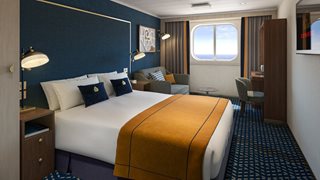
Category: EA
Offering sea views, our deluxe oceanview staterooms provide a private enclave to watch the world go by. Your Britannia Oceanview Deluxe stateroom includes:- Choice of Early, Late, and Open Dining in the Britannia Restaurant.
- Lounge area with seating.
- Cunarder bed configurable to king-size or two single beds.
- Bathroom with a bathtub.
- Additional shower room.
- Window with sea view.
- Satellite TV with movie and music channels.
- Feature vanity and desk with hairdryer.
- UK, USA, European, and USB power sockets.
- Penhaligon's toiletries.
- Bathrobes and slippers.
- Tea and coffee-making facilities.
- Welcome sparkling wine.
- Complimentary room service menu.
- A dedicated steward to keep your stateroom in fine order day and night.

Category: EB
Offering special sea views, our oceanview staterooms provide a private enclave to watch the world go by. Your Britannia Oceanview stateroom includes:- Choice of Early, Late, and Open Dining in the Britannia Restaurant.
- Lounge area with seating.
- Cunarder bed configurable to king-size or two single beds.
- Bathroom with a walk-in shower.
- Window with sea view.
- Satellite TV with movie and music channels.
- Feature vanity and desk with hairdryer.
- UK, USA, European, and USB power sockets.
- Penhaligon's toiletries.
- Bathrobes and slippers.
- Tea and coffee-making facilities.
- Welcome sparkling wine.
- Complimentary room service menu.
- A dedicated steward to keep your stateroom in fine order day and night.

Category: EC
Offering special sea views, our oceanview staterooms provide a private enclave to watch the world go by. Your Britannia Oceanview stateroom includes:- Choice of Early, Late, and Open Dining in the Britannia Restaurant.
- Lounge area with seating.
- Cunarder bed configurable to king-size or two single beds.
- Bathroom with a walk-in shower.
- Window with sea view.
- Satellite TV with movie and music channels.
- Feature vanity and desk with hairdryer.
- UK, USA, European, and USB power sockets.
- Penhaligon's toiletries.
- Bathrobes and slippers.
- Tea and coffee-making facilities.
- Welcome sparkling wine.
- Complimentary room service menu.
- A dedicated steward to keep your stateroom in fine order day and night.

Category: EE
Offering special sea views, our oceanview staterooms provide a private enclave to watch the world go by. Your Britannia Oceanview stateroom includes:- Choice of Early, Late, and Open Dining in the Britannia Restaurant.
- Lounge area with seating.
- Cunarder bed configurable to king-size or two single beds.
- Bathroom with a walk-in shower.
- Window with sea view.
- Satellite TV with movie and music channels.
- Feature vanity and desk with hairdryer.
- UK, USA, European, and USB power sockets.
- Penhaligon's toiletries.
- Bathrobes and slippers.
- Tea and coffee-making facilities.
- Welcome sparkling wine.
- Complimentary room service menu.
- A dedicated steward to keep your stateroom in fine order day and night.

Category: EF
Offering special sea views, our oceanview staterooms provide a private enclave to watch the world go by. Your Britannia Oceanview stateroom includes:- Choice of Early, Late, and Open Dining in the Britannia Restaurant.
- Lounge area with seating.
- Cunarder bed configurable to king-size or two single beds.
- Bathroom with a walk-in shower.
- Window with sea view.
- Satellite TV with movie and music channels.
- Feature vanity and desk with hairdryer.
- UK, USA, European, and USB power sockets.
- Penhaligon's toiletries.
- Bathrobes and slippers.
- Tea and coffee-making facilities.
- Welcome sparkling wine.
- Complimentary room service menu.
- A dedicated steward to keep your stateroom in fine order day and night.
Drink in sparkling sea views from your own private outdoor space in a balcony stateroom, bringing together the best in comfort, convenience, and scenery. Features include a window with sea view, Sealy Cunarder bed configurable to king-size or two single beds, lounge area with seating, satellite TV with movie and music channels, bathroom with a walk-in shower, bathrobes and slippers and more.
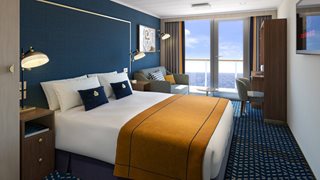
Category: A1
Enjoy prime sea views from your private, outdoor space in one of our Britannia Club Balcony staterooms. Your Britannia Club Balcony stateroom includes:- Access to the intimate Britannia Club restaurant with a reserved table throughout your voyage.
- Private balcony with seating and sea views.
- Lounge area with seating.
- Cunarder bed configurable to king-size or two single beds.
- Bathroom with walk-in shower.
- Satellite TV with movie and music channels.
- Feature vanity and desk with hairdryer.
- UK, USA, European, and USB power sockets.
- Pillow concierge menu with a variety of types to choose from.
- Penhaligon's toiletries.
- Bathrobes and slippers.
- Specialty tea and coffee-making facilities.
- Complimentary spring water replenished throughout your voyage.
- A welcome bottle of sparkling wine.
- Complimentary room service menu.
- A dedicated steward to keep your stateroom in fine order day and night.
- Priority embarkation and disembarkation.

Category: A2
Enjoy prime sea views from your private, outdoor space in one of our Britannia Club Balcony staterooms. Your Britannia Club Balcony stateroom includes:- Access to the intimate Britannia Club restaurant with a reserved table throughout your voyage.
- Private balcony with seating and sea views.
- Lounge area with seating.
- Cunarder bed configurable to king-size or two single beds.
- Bathroom with walk-in shower.
- Satellite TV with movie and music channels.
- Feature vanity and desk with hairdryer.
- UK, USA, European, and USB power sockets.
- Pillow concierge menu with a variety of types to choose from.
- Penhaligon's toiletries.
- Bathrobes and slippers.
- Specialty tea and coffee-making facilities.
- Complimentary spring water replenished throughout your voyage.
- A welcome bottle of sparkling wine.
- Complimentary room service menu.
- A dedicated steward to keep your stateroom in fine order day and night.
- Priority embarkation and disembarkation.

Category: BB
Drink in sparkling sea views from your own private, outdoor space in our Britannia Balcony staterooms. Your Britannia Balcony stateroom includes:- Choice of Early, Late, and Open Dining in the Britannia Restaurant.
- Private balcony with seating and sea views.
- Lounge area with seating.
- Cunarder bed configurable to king-size or two single beds.
- Bathroom with walk-in shower.
- Satellite TV with movie and music channels.
- Feature vanity and desk with hairdryer.
- UK, USA, European, and USB power sockets.
- Penhaligon's toiletries.
- Bathrobes and slippers.
- Tea and coffee-making facilities.
- Welcome sparkling wine.
- Complimentary room service menu.
- A dedicated steward to keep your stateroom in fine order day and night.

Category: BC
Drink in sparkling sea views from your own private, outdoor space in our Britannia Balcony staterooms. Your Britannia Balcony stateroom includes:- Choice of Early, Late, and Open Dining in the Britannia Restaurant.
- Private balcony with seating and sea views.
- Lounge area with seating.
- Cunarder bed configurable to king-size or two single beds.
- Bathroom with walk-in shower.
- Satellite TV with movie and music channels.
- Feature vanity and desk with hairdryer.
- UK, USA, European, and USB power sockets.
- Penhaligon's toiletries.
- Bathrobes and slippers.
- Tea and coffee-making facilities.
- Welcome sparkling wine.
- Complimentary room service menu.
- A dedicated steward to keep your stateroom in fine order day and night.

Category: BD
Drink in sparkling sea views from your own private, outdoor space in our Britannia Balcony staterooms. Your Britannia Balcony stateroom includes:- Choice of Early, Late, and Open Dining in the Britannia Restaurant.
- Private balcony with seating and sea views.
- Lounge area with seating.
- Cunarder bed configurable to king-size or two single beds.
- Bathroom with walk-in shower.
- Satellite TV with movie and music channels.
- Feature vanity and desk with hairdryer.
- UK, USA, European, and USB power sockets.
- Penhaligon's toiletries.
- Bathrobes and slippers.
- Tea and coffee-making facilities.
- Welcome sparkling wine.
- Complimentary room service menu.
- A dedicated steward to keep your stateroom in fine order day and night.

Category: BE
Drink in sparkling sea views from your own private, outdoor space in our Britannia Balcony staterooms. Your Britannia Balcony stateroom includes:- Choice of Early, Late, and Open Dining in the Britannia Restaurant.
- Private balcony with seating and sea views.
- Lounge area with seating.
- Cunarder bed configurable to king-size or two single beds.
- Bathroom with walk-in shower.
- Satellite TV with movie and music channels.
- Feature vanity and desk with hairdryer.
- UK, USA, European, and USB power sockets.
- Penhaligon's toiletries.
- Bathrobes and slippers.
- Tea and coffee-making facilities.
- Welcome sparkling wine.
- Complimentary room service menu.
- A dedicated steward to keep your stateroom in fine order day and night.

Category: BF
Drink in sparkling sea views from your own private, outdoor space in our Britannia Balcony staterooms. Your Britannia Balcony stateroom includes:- Choice of Early, Late, and Open Dining in the Britannia Restaurant.
- Private balcony with seating and sea views.
- Lounge area with seating.
- Cunarder bed configurable to king-size or two single beds.
- Bathroom with walk-in shower.
- Satellite TV with movie and music channels.
- Feature vanity and desk with hairdryer.
- UK, USA, European, and USB power sockets.
- Penhaligon's toiletries.
- Bathrobes and slippers.
- Tea and coffee-making facilities.
- Welcome sparkling wine.
- Complimentary room service menu.
- A dedicated steward to keep your stateroom in fine order day and night.
Delight in a prime, central location on board with ocean views that can be enjoyed from both in and outside your Princess Grill Suite. Features include a Sealy Cunarder bed configurable to king-size or two single beds, lounge area with seating, satellite TV with movie and music channels, bathroom with a large walk-in shower, luxury bathrobes and slippers and more. Enjoy exclusive access to the Princess Grill restaurant and dine anytime at your reserved table.
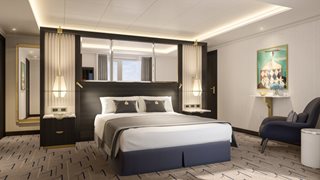
Category: Q1
Retreat to an exclusive world of luxury with your own private residence at sea. Your Queens Grill Grand Suite includes:- Access to the exclusive Queens Grill restaurant, where you can dine anytime at your reserved table.
- Reception hall leading to spacious Great Room with floor-to-ceiling windows, perfect for entertaining.
- Separate dining room.
- Spacious lounge area with seating.
- Bedroom area with Sealy Cunarder bed configurable to king-size or two single beds.
- Pillow concierge menu with seven pillow types to choose from.
- Bathroom with bathtub and walk-in shower.
- Spacious private balcony with seating and sea views.
- Satellite TV with movie and music channels in bedroom and lounge areas.
- Feature vanity and desk with hairdryer.
- Fresh flowers.
- Binoculars and world atlas to track your travels.
- UK, USA, European, and USB power sockets.
- Penhaligon's toiletries.
- Luxury bathrobes and slippers.
- Butler's pantry.
- Complimentary mini-bar stocked with your choice of beer, wine, spirits, and soft drinks.
- Specialty tea and coffee-making facilities.
- Daily fresh fruit.
- Pre-dinner canapés.
- Welcome bottle of Champagne.
- Complimentary room service menu.
- Dine in-suite from the exclusive Queens Grill menu.
- Exclusive access to the Grills Lounge and outside Grills Terrace.
- Concierge service for on-board reservations and shore experiences.
- A dedicated butler and steward to keep your suite in fine order day and night and host the perfect soirée.
- Priority embarkation and disembarkation.
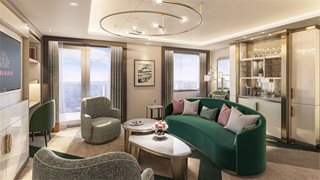
Category: Q2
Retreat to an exclusive world of luxury with your own private residence at sea. Your Queens Grill Master Suite includes:- Access to the exclusive Queens Grill restaurant, where you can dine anytime at your reserved table.
- Reception hall leading to spacious Great Room with floor-to-ceiling windows, perfect for entertaining.
- Separate dining room.
- Spacious lounge area with seating.
- Bedroom area with Cunarder bed configurable to king-size or two single beds.
- Pillow concierge menu with seven pillow types to choose from.
- Bathroom with bathtub and walk-in shower.
- Spacious private balcony with seating and sea views.
- Satellite TV with movie and music channels in bedroom and lounge areas.
- Feature vanity and desk with hairdryer.
- Fresh flowers.
- Binoculars and world atlas to track your travels.
- UK, USA, European and USB power sockets.
- Penhaligon's toiletries.
- Luxury bathrobes and slippers.
- Complimentary mini-bar stocked with your choice of beer, wine, spirits, and soft drinks.
- Specialty tea and coffee-making facilities.
- Daily fresh fruit.
- Pre-dinner canapés.
- Welcome bottle of Champagne.
- Complimentary room service menu.
- Dine in-suite from the exclusive Queens Grill menu.
- Exclusive access to the Grills Lounge and outside Grills Terrace.
- Concierge service for on-board reservations and shore experiences.
- A dedicated butler and steward to keep your suite in fine order day and night and host the perfect soirée.
- Priority embarkation and disembarkation.
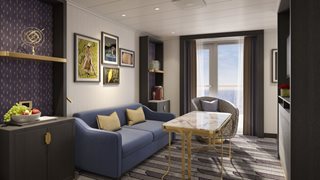
Category: Q3
Retreat to an exclusive world of luxury with your own private residence at sea. Your Queens Grill Penthouse includes:- Access to the exclusive Queens Grill restaurant, where you can dine anytime at your reserved table.
- Spacious lounge area with seating.
- Bedroom area with Cunarder bed configurable to king-size or two single beds.
- Pillow concierge menu with a variety of types to choose from.
- Bathroom with bathtub and walk-in shower.
- Spacious private balcony with seating and sea views.
- Satellite TV with movie and music channels in bedroom and lounge areas.
- Feature vanity and desk with hairdryer.
- Fresh flowers.
- Binoculars and world atlas to track your travels.
- UK, USA, European, and USB power sockets.
- Penhaligon's toiletries.
- Luxury bathrobes and slippers.
- Complimentary mini-bar stocked with your choice of beer, wine, spirits, and soft drinks.
- Specialty tea and coffee-making facilities.
- Daily fresh fruit.
- Pre-dinner canapés.
- Welcome bottle of Champagne.
- Complimentary room service menu.
- Dine in-suite from the exclusive Queens Grill menu.
- Exclusive access to the Grills Lounge and outside Grills Terrace.
- Concierge service for on-board reservations and shore experiences.
- A dedicated butler and steward to keep your suite in fine order day and night and host the perfect soirée.
- Priority embarkation and disembarkation.
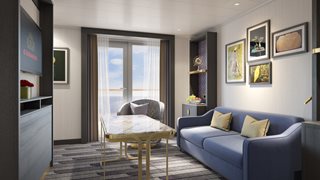
Category: Q4
Retreat to an exclusive world of luxury with your own private residence at sea. Your Queens Grill Penthouse includes:- Access to the exclusive Queens Grill restaurant, where you can dine anytime at your reserved table.
- Spacious lounge area with seating.
- Bedroom area with Cunarder bed configurable to king-size or two single beds.
- Pillow concierge menu with a variety of types to choose from.
- Bathroom with bathtub and walk-in shower.
- Spacious private balcony with seating and sea views.
- Satellite TV with movie and music channels in bedroom and lounge areas.
- Feature vanity and desk with hairdryer.
- Fresh flowers.
- Binoculars and world atlas to track your travels.
- UK, USA, European, and USB power sockets.
- Penhaligon's toiletries.
- Luxury bathrobes and slippers.
- Complimentary mini-bar stocked with your choice of beer, wine, spirits, and soft drinks.
- Specialty tea and coffee-making facilities.
- Daily fresh fruit.
- Pre-dinner canapés.
- Welcome bottle of Champagne.
- Complimentary room service menu.
- Dine in-suite from the exclusive Queens Grill menu.
- Exclusive access to the Grills Lounge and outside Grills Terrace.
- Concierge service for on-board reservations and shore experiences.
- A dedicated butler and steward to keep your suite in fine order day and night and host the perfect soirée.
- Priority embarkation and disembarkation.
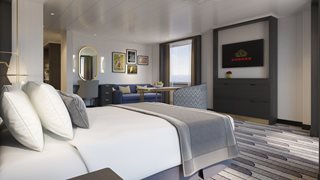
Category: Q5
Retreat to an exclusive world of luxury with your own private residence at sea. Your Queens Grill Queens Suite includes:- Access to the exclusive Queens Grill restaurant, where you can dine anytime at your reserved table.
- Spacious lounge area with seating.
- Bedroom area with Cunarder bed configurable to king-size or two single beds.
- Pillow concierge menu with a variety of types to choose from.
- Bathroom with bathtub and walk-in shower.
- Spacious private balcony with seating and sea views.
- Satellite TV with movie and music channels in bedroom and lounge areas.
- Feature vanity and desk with hairdryer.
- Fresh flowers.
- Binoculars and world atlas to track your travels.
- UK, USA, European, and USB power sockets.
- Penhaligon's toiletries.
- Luxury bathrobes and slippers.
- Complimentary mini-bar stocked with your choice of beer, wine, spirits, and soft drinks
- Specialty tea and coffee-making facilities.
- Daily fresh fruit.
- Pre-dinner canapes.
- Welcome bottle of Champagne.
- Complimentary room service menu.
- Dine in-suite from the exclusive Queens Grill menu.
- Exclusive access to the Grills Lounge and outside Grills Terrace.
- Concierge service for on-board reservations and shore experiences.
- A dedicated butler and steward to keep your suite in fine order day and night and host the perfect soirée.
- Priority embarkation and disembarkation.

Category: Q6
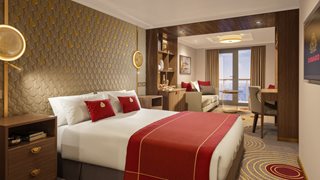
Category: P1
Delight in a prime and central location with sea views from your Princess Suite. Your Princess Suite includes:- Exclusive access to the Princess Grill restaurant, where you can dine anytime at your reserved table.
- Private balcony with seating and sea views.
- Spacious lounge area with seating.
- Bedroom area with Cunarder bed configurable to king-size or two single beds.
- Pillow concierge menu with a variety of types to choose from.
- Bathroom with large walk-in shower.
- Satellite TV with movie and music channels in lounge and bedroom areas.
- Feature vanity and desk with hairdryer.
- UK, USA, European, and USB power sockets.
- Penhaligon's toiletries.
- Luxury bathrobes and slippers.
- Feature mini-bar with specialty tea and coffee making facilities.
- Complimentary spring water replenished throughout your voyage.
- Welcome bottle of sparkling wine.
- Complimentary room service menu.
- Dine in-suite from the exquisite Princess Grill menu.
- Exclusive access to the Grills Lounge and outside Grills Terrace.
- Concierge service for on-board reservations and shore experiences.
- A dedicated steward to keep your suite in fine order day and night.
- Priority embarkation and disembarkation.

Category: P2
Delight in a prime and central location with sea views from your Princess Suite. Your Princess Suite includes:- Exclusive access to the Princess Grill restaurant, where you can dine anytime at your reserved table.
- Private balcony with seating and sea views.
- Spacious lounge area with seating.
- Bedroom area with Cunarder bed configurable to king-size or two single beds.
- Pillow concierge menu with a variety of types to choose from.
- Bathroom with large walk-in shower.
- Satellite TV with movie and music channels in lounge and bedroom areas.
- Feature vanity and desk with hairdryer.
- UK, USA, European, and USB power sockets.
- Penhaligon's toiletries.
- Luxury bathrobes and slippers.
- Feature mini-bar with specialty tea and coffee making facilities.
- Complimentary spring water replenished throughout your voyage.
- Welcome bottle of sparkling wine.
- Complimentary room service menu.
- Dine in-suite from the exquisite Princess Grill menu.
- Exclusive access to the Grills Lounge and outside Grills Terrace.
- Concierge service for on-board reservations and shore experiences.
- A dedicated steward to keep your suite in fine order day and night.
- Priority embarkation and disembarkation.

| Symbol | Description |
|---|---|
 | 2 lower berths and 1 upper berth |
 | 3rd berth is a single sofabed |
 | 3rd and 4th berth is a double sofabed |
 | Balcony is shaded by deck structure above |
 | Wheelchair accessible |
 | Alternative layout and configuration |
 | Forward-facing ocean view |
 | Partial metal-fronted balcony |
 | Metal-fronted balcony |
 | Views obstructed by lifeboats and during Panama Canal transits lifeboats are adjacent to the balcony |
 | Balcony visible from above |
 | Additional shower room |
 | 3rd and 4th berth are a single sofabed and one upper bed |
 | Indicates powered mobility device friendly stateroom |
 | Indicates configuration with no sofa, sitting chair only |
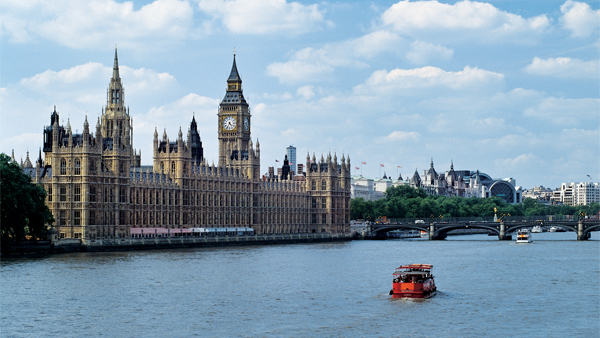
- Ship Name: Queen Anne
- Year Built: 2022
- Year Entered Present Fleet: 2024
- Maximum Capacity: 3,353
- Number of Passenger Decks: 13
- Number of Crew: 1,225
- Ocean-View without Balcony: 113
- Ocean-View with Balcony: 685
- Total Inside Staterooms: 348
- Tonnage (GRT): 113,000
- Capacity Based on Double Occupancy: 3,000
- Country of Registry: Bermuda
- Total Staterooms: 1,397
- Suites with Balcony: 253
Costco Member Reviews

Available Dates & Prices
Terms & Conditions
*Price shown is per person based on double occupancy and is valid for select stateroom categories only. Click on the Terms & Conditions link below for details.
†One Digital Costco Shop Card per room/stateroom, per stay. The exact amount of the Digital Costco Shop Card will be calculated during the booking process. The Digital Costco Shop Card promotion is nontransferable and may not be combined with any other promotion. A Digital Costco Shop Card will arrive by email approximately 10 days after the start of your cruise. Click on the Terms & Conditions link below for additional information.
© Carnival plc. Ships' Registry: Bermuda. The Cunard logo and logotype, Queen Mary 2, Queen Victoria, Queen Elizabeth, and Queen Anne are registered trademarks of Carnival plc, an English company trading as Cunard.
Digital Costco Shop Card
Book this vacation or cruise with Costco Travel and receive a Digital Costco Shop Card. The Digital Costco Shop Card is a convenient payment option in our warehouses and on Costco.com.
















